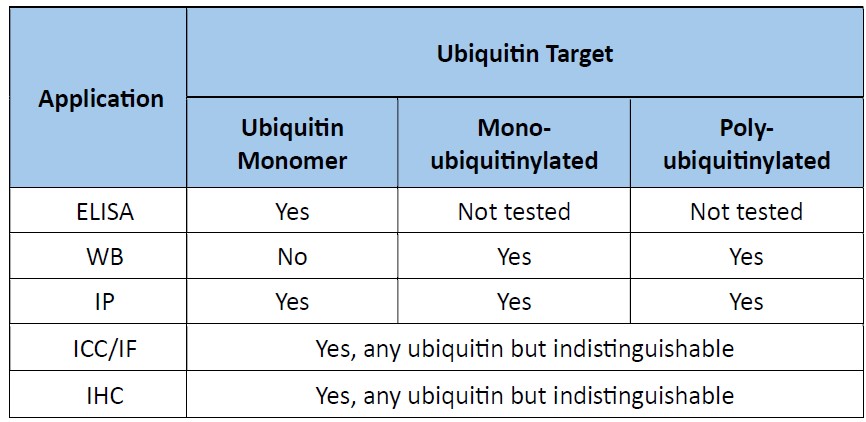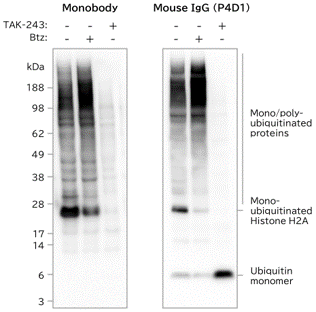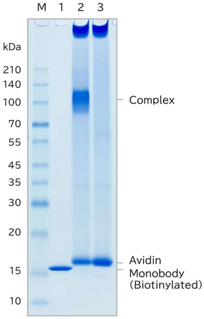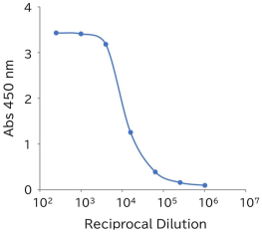Anti Pan Ubiquitin Monobody (Biotin labeled)
Cosmo Bio
- Catalog No.:
- CAC-MB-001-B
- Shipping:
- Calculated at Checkout
Anti-Pan Ubiquitin Monobody (Biotin labeled)
Description
This product is a pan-ubiquitin monobody (single-chain antibody mimic) that recognizes ubiquitin monomers and mono- and poly-ubiquitinated proteins. It boasts several features (described below) that establish its superiority over current pan-ubiquitin monoclonal antibodies such as FK2 and P4D1. It is ideal for immunoprecipitation (IP), immunofluorescence (IF), immunohistochemistry (IHC), immunocytochemistry (ICC), Western blot (WB) and ELISA.
*This product is commercialized under license from the Tokyo Metropolitan Institute of Medical Science, Tokai National University Organization, and Kyoto University.
Features
- High affinity - Among the ubiquitin-binding clones screened from a monobody combinatorial library of 1013 clones, one with the highest binding affinity was selected for commercialization. High affinity IgG antibodies generally exhibit dissociation constants (KDs) in the low nanomolar range. By contrast, biolayer interferometric analysis revealed the KD of our monobody to be 0.88 nM, indicating extremely high affinity.
- High permeability - Monobodies – like nanobodies (VHH antibodies) - are 1/10 the size of IgG, accounting for their excellent permeability. In immunofluorescence staining, our pan-ubiquitin monobody was better able to detect ubiquitin than FK2, a current popular pan-ubiquitin mouse monoclonal antibody (Figure 1).
- Low bias - Our monobody efficiently immunoprecipitates ubiquitin monomers and mono-ubiquitinated histones (Figure 3), a task that current pan-ubiquitin mouse monoclonal antibodies (FK2 and P4D1) cannot accomplish. Our monobody is also excellent at immunoprecipitation of polyubiquitinated proteins, with all eight ubiquitin linkages (K6, K11, K27, K29, K33, K48, K63, M1) recovered efficiently and, importantly, in proportions that closely match those detected in input cell extract (Figure 4). Together, these results indicate that our monobody binds with low bias across all ubiquitin chain types, likely due to its small size and extremely high affinity
- Artificial antibody - Our monobody is an artificial antibody, based on a structure derived from the fibronectin type III domain (FN3). It is C-terminally fused with a His tag and manufactured under animal-free conditions using an E. coli expression system and affinity purification. The C-terminus is also labeled with biotin, and the use of an avidin/streptavidin reagent is recommended for detection and immobilization of this product. Please refer to the related products below .

Diagrammatic size comparison – monobody vs IgG

Verified monobody applications
- Immunoprecipitation (IP)
- Immunocytochemistry (ICC)
- Immunofluorescence (IF)
- Immunohistochemistry (IHC)
- Western blot (WB)
- ELISA
* Monobodies have high specific activity, and better results are obtained at higher dilutions (lower concentrations) than those used with conventional antibody products.
Examples of use
Immunofluorescence staining – monobody vs IgG
Figure 1. Immunofluorescence microscopy with pan-ubiquitin monobody or pan-ubiquitin mouse monoclonal antibody FK2. HCT-116 cells stably expressing EGFP-ubiquitin fusion protein were treated with puromycin to induce the formation of ubiquitin-positive aggregates, and then treated with (A) TAMRA-labeled pan-ubiquitin monobody or (B) pan-ubiquitin mouse monoclonal antibody FK2 and Alexa 568-labeled secondary antibody. Data was provided by the Tokyo Metropolitan Institute of Medical Science.
Western blot – monobody vs IgG
Figure 2. Western blot of ubiquitinated proteins with pan-ubiquitin monobody or pan-ubiquitin mouse monoclonal antibody P4D1. Lysates from HCT-116 cells treated with TAK-243 (inhibitor of Ubiquitin activating enzyme), Btz (proteasome inhibitor) or nothing (-) were Western blotted with pan-ubiquitin monobody (left) or pan-ubiquitin mouse monoclonal antibody P4D1 (right) and visualized using HRP and chemiluminescence. Mono-ubiquitinated histone H2A and small mono/poly-ubiquitinated proteins were detected more strongly with the monobody than with P4D1.
*This product recognizes ubiquitin monomers by ELISA (Figure 6) and immunoprecipitation (Figure 3) but not by Western blotting as shown above in Figure 2.
Immunoprecipitation – monobody vs IgG

Figure 3. Immunoprecipitation with pan-ubiquitin monobody or pan-ubiquitin mouse monoclonal IgG antibodies FK2 and P4D1. HCT-116 cell extracts were immunoprecipitated with pan-ubiquitin monobody or mouse monoclonal IgG antibodies FK2 and P4D1, followed by Western blotting with P4D1. Only the pan-ubiquitin monobody was able to immunoprecipitate ubiquitin monomers and mono-ubiquitinated Histone H2A.
Immunoprecipitationbias across ubiquitin linkage types – monobody vs IgG
Figure 4. Quantitative mass spectrometry of pan-ubiquitin monobody and monoclonal immunoprecipitates. The immunoprecipitates from Figure 3 (above) 62 kDa or greater were subjected to quantitative mass spectrometry using LC-MS/MS. The quantitative distribution of ubiquitin linkages immunoprecipitated with our monobody closely mirrored that of the input lysate, as compared to the distorted distribution resulting from immunoprecipitation with monoclonal IgG P4D1.
Monobody – high purity and extent of biotinylation
Figure 5. SDS-PAGE analysis of purity and extent of biotinylation. 1 µg of pan-ubiquitin monobody (1), 1 µg of pan-ubiquitin monobody incubated with 5 µg avidin (2), and 5 µg avidin (3) were separated by SDS-PAGE and stained with CBB. The result shows that the monobody is highly pure and biotin-labeled at high yield.
Monobody – monomeric ubiquitin detection by ELISA
Figure 6. Binding of pan-ubiquitin monobody to immobilized human ubiquitin monomers. Dilution series of pan-ubiquitin monobody (0.5 mg/mL) reacted on an immunoassay plate coated with recombinant human ubiquitin monomer (1 µg/well), followed by secondary reaction with NeutrAvidin-HRP. The result shows the pan-ubiquitin monobody binds with high potency to recombinant human monomeric ubiquitin in ELISA.
| Product Specifications | |
| Application | IP, IHC, ICC, IF, WB |
| Reactivity | All |
| Clonality | Monobody |
| Documents & Links for Anti Pan Ubiquitin Monobody (Biotin labeled) | |
| Datasheet | Anti Pan Ubiquitin Monobody (Biotin labeled) Datasheet v1.1 |
| Flyer | Anti Pan Ubiquitin Monobody (Biotin labeled) Flyer |
| Documents & Links for Anti Pan Ubiquitin Monobody (Biotin labeled) | |
| Datasheet | Anti Pan Ubiquitin Monobody (Biotin labeled) Datasheet v1.1 |
| Flyer | Anti Pan Ubiquitin Monobody (Biotin labeled) Flyer |













